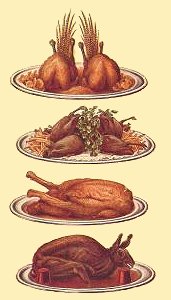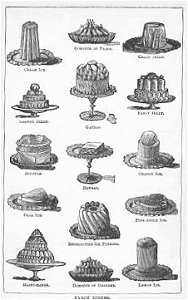 |
Recipe Books
Recipe books became part of the popular press
thanks to Isabella Mary Beeton’s “Book of Household Management”
which was first published in 1861. For many years it was the
best selling book on the topic and became a “must” for the
well-appointed Victorian kitchen. There are chapters on
preparing all kinds of food and drinks; food for invalids;
domestic servants; the rearing and management of children;
diseases of infancy and childhood; and the doctor. The book is
over 1,000 pages long and offers advice on such diverse subjects
as etiquette, animal husbandry, poisons and fashion. It is well
illustrated with coloured engravings on nearly every page and
was the first book to lay recipes out in the form that we still
use today.
Isabella Beeton was born in Cheapside, London in 1836 to
Benjamin and Elizabeth Mayson and educated at Heidelberg. She
became an accomplished pianist and married Samuel Orchard Beeton
in 1856. |
| Her famous book was written when she was only 22
years old, but her life was filled with tragedy. Their first child
Samuel died in September 1859 and soon afterwards the couple had a
second child also called Samuel. The winter of 1858 was very severe
and Isabella opened a soup kitchen at her home for the poor children
of Hatch End and Pinner. She had a very short life, dying from
puerperal fever at the age of 28.
Although there were other Victorian recipe books, Mrs. Beeton’s
is the one we all remember, giving the middle-class housewife
and her staff much of the information required to run the
“perfect home”. Cooks could experiment like never before using
many of the new ingredients that appeared in the shops from all
over the Empire. The newly built railways enabled fresh food to
be quickly and cheaply transported over long distances and new
techniques such as canning and bottling were developed for
preserving food. In the 1860s cheap ice was available and
refrigerated transport appeared in the 1880s. |

| Illustrations from
Mrs. Beeton's book. |
|
| The following is a brief description of a typical
Victorian middle-class household where the early recipe books would
be found. It is worth noting that many working-class families and
poorer families would not even have been able to afford to buy a
recipe book let alone some many the ingredients mentioned within. |
 |
Victorian and
Edwardian Kitchens
What were kitchens like when Mrs. Beeton’s
book first appeared? They were certainly very different from
what we know today. Victorian families were often large with
maybe 10 children and several servants to feed and look after.
The kitchen was a hive of activity with a lot of work to be
done. |
|
Cooking was often done by the cook rather
than the lady of the house on a cast iron kitchen range, which
had a raised open fire in the centre with an oven on either
side. A cooking pot could be hung over the fire on a hook and
items could be roasted in front of the fire on a spit, which was
turned by hand or even operated by a clockwork motor. A large
tin would be placed underneath to catch the fat. The range was
also used for heating water. A boiler at the back provided all
of the hot water for cooking, washing and household needs. Gas
ovens slowly replaced the kitchen range. Early versions were
exhibited at the Great Exhibition of 1851 but they were slow to
catch-on. People were afraid of gas explosions and eating food
that had been exposed to harmful gas fumes. Gas cookers didn’t
sell in large numbers until the 1890s when they gradually
replaced most of the old solid fuel ranges in middle-class
homes. In many working-class homes it was a different story,
ranges continued in use until well into the twentieth century.
A large wooden table would be used as the
work surface and would be carefully scrubbed-down between each
use. There would be a large wooden dresser with open shelves for
crockery and drawers for table linen and cutlery, and possibly a
square or rectangular “Belfast” sink.
Gas lighting would be installed in the more
affluent homes, others would have used oil lamps. Walls were
often finished with white or distempered plaster, or even
varnished paper for ease of cleaning. Glazed wall tiles became
more affordable in the 1890s and they became very popular being
so easy to clean. Windows were very high to provide efficient
ventilation and floors were made of stone slabs or unglazed
tiles.
Food was stored in the pantry or larder, a
room off the kitchen that was sometimes fitted with slate or
marble shelves to help keep the food cool. Such things as
washing-up, vegetable preparation and laundry work were done in
the scullery. Even smaller houses had a scullery and often it
would contain the only sink in the house. It wasn’t until the
twentieth century that kitchen sinks became popular.
The kitchen was a busy place with so many
mouths to feed thanks to the large families that were
commonplace at the time. Labour saving devices were a necessity
and all kinds of aids were developed. There were knife
sharpeners; lemon graters; lemon squeezers; parsley choppers;
sugar snippers to cut pieces of sugar from a slab; potato
peelers; mincers; and even hand-operated food processors. The
electric kettle was invented by Crompton and Company in 1891 and
temperature controlled ovens were developed that used a
complicated system of flues and metal plates. The cook could now
prepare the more complex meals that had previously only been
enjoyed by the wealthy. |
|
Cleaning the kitchen
In Victorian times few proprietary cleaning
agents were available. Recipe books sometimes contained formulas
for making your own. Knives and utensils could be cleaned with
abrasives such as emery powder, and rust was removed with a
mixture of turpentine, camphor and emery powder. Glass could be
cleaned with methylated spirit on a cloth and then polished with
a leather, and brass and tin could be cleaned using a mixture of
rape oil and rottenstone. Silver could be polished using a
mixture of chalk, ammonia, alcohol and water. Drains were
disinfected with chloride of lime and all animal and food refuse
was burned.
Washing powders are a modern invention, in
those days a blue bag was used instead. We all take furniture
polish for granted today whereas in Victorian times this was
often made from a mixture of beeswax, white wax, turpentine and
white soap. |

Another illustration
from Mrs.
Beeton's book. |
|
|
Domestic Servants
Domestic servants were commonplace in
middle-class homes, working-class families relied upon their
children to do much of the work.
Smaller houses had only one servant, a maid
of all work. She did all of the household work including
cooking, cleaning, washing, shopping, and lighting and tending
to the coal fires. She lived in the house and possibly only had
one week’s holiday a year.
A larger house would have had several
servants. There would have been a cook who prepared the meals
for both the family and servants, a scullery maid who did all of
the dirty jobs such as washing up, doing the laundry, scrubbing
floors and preparing coal fires. There would also be one or more
housemaids who looked after the family and did all of the
general housework.
Mrs. Beeton was by no means the first lady to
produce a recipe book but she did inspire many others to do the
same, aided by the Victorian’s emphasis on self-improvement and
the growth of education.
Old recipes are evocative of the past and are
fun to follow and try out, giving us an opportunity to sample
some of our ancestor's favourite food.
 |
Return to the
list of recipes |
|
|